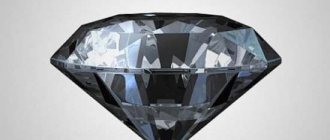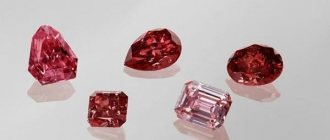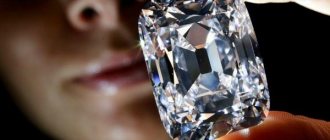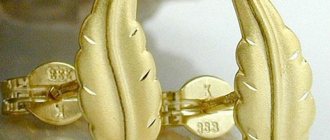The black diamond is considered a mysterious creation of nature, the extraterrestrial origin of which is attributed to an asteroid crashing into the Earth or meteor showers. For many years this natural stone was considered an “outcast” among diamonds and was used only for industrial purposes. But today, matte crystal has become one of the top sellers among jewelry, attracting buyers with its deep glow, unearthly beauty, mystery and enigma.
Nobody needs gems
For thousands of years, diamonds with low levels of color and transparency were found among precious gems of incredible purity in ancient mines. Their pores were filled with coal and graphite. Such a stone had a gray or dark brown color, low transparency and was considered unsuitable for cutting. It was purchased by artisans and jewelers who processed other precious minerals and high-quality diamonds.
To simplify the designation of unsuitability for processing, jewelers gave them the name black diamonds. In rare cases, only very large crystals were cut, and gray-black-brown stones were simply ignored.
The exception was the black “Great Mogul” diamond, which weighed 787 carats, and the 279 carat jewel made from it symbolized the power of the Iranian shahs. After the assassination of Nadir Shah, the “Great Mogul” disappeared without a trace.
Some researchers claim that the Orlov diamond (199.6 carats) stored in the Diamond Fund of the Russian Federation was bought by Grigory Orlov, a favorite of Empress Catherine II, at the end of the 18th century and is a recut “Great Mogul”.
Detection of extraterrestrial carbonados
In 1840, in eastern Brazil, a black diamond was discovered for the first time, which had a polycrystalline structure unusual for terrestrial conditions. The stone lay shallow. Thanks to inclusions of graphite and coal, it had a uniform dark color, which is why it received the meaning carbonado (coal).
Due to the porous structure and large amount of waste, professional cutting of carbonado was difficult and unprofitable. Therefore, it was used in the manufacture of sanding tools for woodworking.
Several decades later, deposits of carbonado were found in western Africa, which allowed scientists to develop a version of its origin.
Approximately 3-4 billion years ago, the Earth was a single continent, in which the current eastern coast of Brazil came into contact with western Africa.
In this area, a particularly large meteorite crashed into our planet, consisting of diamonds that were subjected to high pressure and temperature. A powerful explosion scattered parts of the space guest over hundreds of kilometers. This version explains why diamonds with similar characteristics are never found in kimberlite pipes.
History and origin
The Greeks called diamond adamas, which translates as indestructible. It is believed that the first stone was found in India more than 6,000 years ago. However, due to its phenomenal hardness, people were able to enjoy its brilliance only in the 15th century. Until this time, it was simply impossible to process the nugget.
The first deposit of black diamonds was in Brazil in 1840. Local miners called them carbonado because of their charcoal color. .
It is believed that Indian craftsmen first learned to polish nuggets. But jewelers from Amsterdam have achieved perfection in cutting diamonds.
One of the first fans of diamonds was Agnes Sorel (a favorite of Cara VII) more than 500 years ago. She was the first to notice how diamonds sparkled and began wearing jewelry with them.
Julius Caesar and Napoleon used diamonds as a talisman. In Russia it became popular thanks to Catherine the Great in 1500.
There are 2 versions of the origin of the black diamond: cosmic and terrestrial. According to the first, amazing crystals appeared on Earth along with meteorites after a supernova explosion. When they hit the earth's surface, an airless layer with enormous pressure formed inside them, in which diamonds appeared.
According to the second version, a rare black crystal was formed in kimberlite pipes, which are formed after the explosion of underground volcanoes. Other types of diamonds are found in such depressions, and black ones get their unique color due to an admixture of graphite or iron.
Important! Both theories are still relevant today, since most of the deposits are located on or near the earth's surface. In addition, deposits of black nuggets are located in different parts of the planet, separate from other types of diamonds.
Marketing move by Fawaz Gruosi
The black diamond received a new birth only in the 90s of the last century, when the founder of the de Grisogono jewelry house, Fawaz Gruosi, threw amazingly beautiful jewelry onto the market, into which he inserted a beautifully cut black stone with a scattering of gems of a wide variety of shades.
The paradox of the situation was that surrounded by white gold and platinum, a matte black diamond looked very advantageous. The legend of extraterrestrial origin and magical properties attracted the attention of buyers.
In just a few years, prices for previously unwanted stones instantly increased by more than 20 times, making the de Grisogono jewelry house a real trendsetter.
Let's look at what a black mineral is and how it relates to carbonado of extraterrestrial origin.
The natural color of pique is far from black
Most often, products with black diamonds have nothing to do with carbonado, which is difficult to cut. Due to its layered-porous structure, the stone crumbles heavily and loses up to 80% of its own weight during processing.
Therefore, pique diamonds began to be used as black diamonds. These are colored single crystals, which in structure do not differ from high-quality “pure water” diamonds. They have dark gray and brown-black colors and extremely low transparency.
To give a more saturated black color, low-quality stones are refined under the influence of targeted X-ray irradiation and ultra-high temperatures. Refined diamonds (reg) change color while maintaining other physical and chemical characteristics, which is why their value increases significantly.
What are black diamonds?
Diamonds are cut diamonds. The color that the diamond has will be the color of the diamond. Few people knew about black jewelry diamonds just a few decades ago. They became widely available at affordable prices relatively recently. There are two types of stones, which in their physical and chemical properties are related to diamonds and are black in color. However, there are big differences between them.
Carbonado
The so-called black diamonds or carbonado (from the Spanish carbón - coal) have been known since the 18th century. Carbonado deposits were discovered in Brazil and then in the Central African Republic. They are never found in deposits with regular diamonds, indicating their different origins.
Carbonado is a polycrystalline formation formed by many tightly welded tiny diamonds in a siliceous base. The bonding of crystals is not uniform, so carbonado has a porous structure. It contains graphite and iron compounds - hematite and magnetite, which cause a dark color. A large number of inclusions makes carbonado opaque. The relative arrangement of diamond crystals does not reflect light, but rather absorbs it, depriving the formation of the famous diamond shine or “game”. The peculiarities of the polycrystalline structure determine the extreme strength of carbonado, in contrast to ordinary diamonds, which are quite fragile. At the same time, the mineral maintains the hardness of diamond.
Carbonados have always been used only for technical purposes and have an extremely low cost. They were never seriously considered as potential diamonds. Of the famous “4C” quality parameters of diamonds (cut, clarity, color, weight), carbonados have only three, and clarity (or transparency) is missing. In addition, due to its extreme hardness, carbonado is difficult to cut, and the porous structure and abundance of inclusions do not allow for high-quality polishing. It is common to lose 50-60% of the stone's weight during processing.
However, with the development of diamond processing technology, black diamonds made from carbonado began to appear. At first, for these purposes, stones with a uniform color and unique weight were selected - from 10 carats and above. Nowadays there are black carbonado diamonds weighing less than 1 carat.
Natural black diamonds
Besides carbonado, there is another type of black diamond found in nature. It consists of black single crystals , whose properties are familiar to us as jewelry diamonds. These truly rare stones truly exhibit a natural black color due to inclusions of graphite. Such diamonds can also include crystals with a dark, thick gray, brown or green color, which in reflected light will look like black. They are opaque or translucent, mostly with various inclusions that complicate their processing. However, if the diamond has an even color and minimal internal defects, then it can produce an excellent quality black diamond.
Determines the naturalness of a gemstone
If you decide to purchase a gold ring with a black diamond or other jewelry, you should be able to tell the difference between a real carbonado and pique, as well as a low-quality artificial diamond.
Remember that real piques, unlike carbonados and artificially enhanced diamonds, are very rare and expensive, which forces enterprising dealers to replace them with less expensive stones.
The surface of black diamonds is never perfect and has visible errors.
You can distinguish a natural dark-colored piqué from an artificially refined stone using:
- LED lamp;
- magnifying glasses with tenfold magnification;
- electrical conductivity test.
Light the stone with an LED lamp. True pique is opaque. It has a smoky or deep gray (but not black) color. If the stone has brown or greenish tints, this means that it has been artificially refined.
Take a magnifying glass with 10x magnification and examine the jewelry. In piqué diamonds, the color in the crystal is distributed evenly, while imitation diamonds have a patchy color distribution.
Perform a conductivity test. For treated diamonds, it differs significantly from natural indicators.
How to spot a fake
Let us clarify: fancy stones, that is, cut pique, are offered only at auctions. Jewelry stores offer processed carbonados (they are cheaper than transparent ones).
There are three methods to give diamonds a natural black color to increase their value: irradiation, firing, and painting. The first time the stones take on a dark, rich green hue. High firing temperature (second method) turns coal into graphite.
Black brilliant
You can identify the origin as follows:
- Examine the stone against the light under an LED lamp: the piqué is opaque, smoky or deep gray. The tinted fake is distinguished by its brownish or green color. In opaque crystals, the shade of color is concentrated at the tip of the edges.
- In treated minerals, graphite inclusions are concentrated just below the surface of the stone, creating a black tint. Dispersion throughout the volume means the natural origin of the stone.
- Under a tenfold magnifying glass, the color of the piqué is uniform; the treated crystal exhibits spotting, variegation, and iridescence of shades.
- A reliable way is to test a sample for electrical conductivity. For transparent and natural black crystals it is the same, but for processed ones it is different. This method is available to specialists.
Technologists have created an artificial black carbonado diamond. The process involves high pressure using nickel as a catalyst.
The healing properties of a guest from space
In recent years, black diamond jewelry has become widespread. They are purchased with pleasure by people with varying degrees of wealth. This was greatly facilitated by the information that jewelry with dark stones have healing and magical properties.
Traditional healers and psychics claim that carbonado formed in deep space strengthens sleep and immunity, treats mental disorders, heart and stomach diseases, and normalizes the functioning of the central nervous system and respiratory organs.
Earrings and pendants with black diamonds are recommended for women. Rings with a dimly shining black diamond and a pendant on a white gold chain will give the owner aristocracy and attract the admiring glances of others. Men wearing such stones quickly build their careers and achieve great heights in business.
The energy of black diamonds adds determination, perseverance and endurance to a man’s character, helping him to overcome any difficult situations with dignity.
What is a black diamond and its history
The exact origin story is unknown. Information about black diamonds first appeared in Brazil and Africa. According to one hypothesis, a supernova explosion occurred, after which meteorites with this gem fell to the ground. According to another theory, the stone came to the surface of the earth during a volcanic eruption.
The gem was introduced into the world of fashion by designer Fawaz Gruosi. He bought nondescript minerals at a low price and created jewelry from them. The novelty quickly became known, and the price of the stone increased 20 times. To this day, the De Grisogono brand is considered a trendsetter in jewelry with black diamonds.
Black diamond refers to several options:
- remaining as waste after processing high-quality gems - diamond chips;
- polycrystalline porous mineral – carbonado;
- single-crystalline mineral with impurities - pique.
An example of what a raw mineral and jewelry with it looks like:
Connection with magic and astrology
It is believed that the magical properties of the stone help people pacify anger and irritation, achieving emotional stability. He himself is under the influence of the Sun and Venus, so he is not suitable for every zodiac sign.
Carbonado is recommended to be worn by representatives of the element of Fire: Sagittarius, Leo and Aries, and it helps Capricorns achieve serious success in any field of activity.
Those who can wear carbonado safely are Virgos, Sagittarius and Scorpios. For them, products with a dark diamond will become simple jewelry, not filled with magic, and no otherworldly entities will be able to disturb their peace.
It is not recommended for Pisces to carry black-gray diamonds. The magical properties and energy of the stone are absolutely not suitable for representatives of the sign.
Black diamonds do not tolerate dishonesty and dishonesty, so it is better for such people to refrain from purchasing jewelry.
Who is suitable according to their zodiac sign?
Astrologers have found that the stone suits several zodiac signs to varying degrees. His favorites are representatives of the element of Fire. But zodiac compatibility is not enough: the black mineral does not tolerate dishonesty. If this quality dominates, it is better not to count on the help of a magician stone.
| Zodiac sign | Compatibility |
| Aries | +++ |
| Taurus | + |
| Twins | + |
| Cancer | + |
| a lion | + |
| Virgo | + |
| Scales | +++ |
| Scorpion | + |
| Sagittarius | + |
| Capricorn | + |
| Aquarius | + |
| Fish | + |
(“+++” – fits perfectly, “+” – can be worn, “-” – is strictly contraindicated)
Cost of black diamonds
How much black diamonds can cost depends on their weight, color saturation and cut. Due to the lack of transparency, the light ray is not refracted, but reflected from the carefully polished edges. Therefore, jewelers try to give the stone as many facets as possible.
For example, in the world famous teardrop-shaped “Amsterdam” there are 145 of them, although similar processing of transparent stone involves the application of 57-58 facets.
1 carat of a dark diamond with artificially changed color costs about 150 US dollars, a carbonado - 400-500, and a natural pique - from 1.5 to 3 thousand dollars.
Remember that there are a large number of treated diamonds on the market. Almost all of them are subjected to irradiation, film coating, and processing using high pressure and temperature.
The technology of burning inclusions using a laser beam and filling the voids with an artificial crystalline mass that does not change the physical properties of the stone has become widespread.
Physico-chemical properties of diamond
Diamond is a cubic polymorph of carbon. In its pure form it is absolutely transparent, but metal impurities give it color. Color can be changed by irradiation.
Properties:
| Color | Colorless |
| Shine | Diamond |
| Transparency | From transparent to opaque |
| Mohs hardness scale | 10 |
| Density g/cm3 | 3,5 |
| Refractive index | 2,4 |
Diamond is the standard mineral. It ranks highest on the Mohs scale. The next hardest stone is corundum, but the difference in hardness is huge, 180 times. Hardness does not mean strength. If you hit a stone, it will crumble.
The myth of toughness failed the mercenaries of Louis XI, who captured the jewels of Charles the Bold. They split half the treasury, checking the diamonds for authenticity. After making sure that these were pieces of glass, the mercenaries threw out the debris.
The enterprising mineralogist Wollaston used this property of the diamond to his advantage. He bought diamonds with internal defects for next to nothing, split them and sold them as individual stones.
The recognizable brilliant shine is given to the mineral by a high degree of light refraction and dispersion (decomposition of light).
An interesting property of the stone is luminescence. If the diamond stays in the sun, it will begin to glow faintly in the dark.











